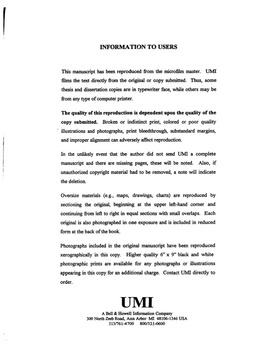| dc.contributor.advisor | Shambaugh, Robert L., | en_US |
| dc.contributor.author | Chhabra, Rajeev. | en_US |
| dc.date.accessioned | 2013-08-16T12:29:54Z | |
| dc.date.available | 2013-08-16T12:29:54Z | |
| dc.date.issued | 1997 | en_US |
| dc.identifier.uri | https://hdl.handle.net/11244/5563 | |
| dc.description.abstract | An experimental study of fiber motion and nonwoven webs in melt blowing was done. Fiber motion was characterized in terms of the fiber vibrations--amplitude and frequency of vibrations--and the fiber position distribution. Fiber amplitude was measured with both multiple image flash photography and laser Doppler velocimetry. Fiber frequency was measured with laser Doppler velocimetry. The fiber frequency experimental results were compared to the predictions of Rao and Shambaugh model for melt blowing. The fiber amplitude results showed that the fiber cone was elliptical. The elliptical nature of the fiber cone was further confirmed with the fiber position distribution study. High speed flash photography was used to determine the fiber positions in three-dimensional space below a melt blowing die. For the planes transverse to the spinning direction, the fiber distribution was found to follow a unimodal bivariate probability distribution, and the experimental data were fit to a bivariate normal distribution. Furthermore, it was found that the fiber laydown pattern or the web distribution also follows a bivariate normal distribution. An image analysis technique, based on Kullback-Leibler information principle, was developed to evaluate the distribution of fibers in a melt-blown web. The parameters of the web distribution were correlated to the melt blowing process variables--air velocity, air temperature, polymer flow rate and polymer temperature. The web distribution was found to increase (a) linearly with the axial position below the die, and (b) for process conditions that reduced the fiber diameter. To further understand the melt blowing process, the air turbulence structure of the rectangular, inclined cross-jets were studied using a hot-wire anemometer. The axial mean velocity, turbulence intensity, skewness factor, and flatness factor profiles were determined for both continuous and oscillating flows. | en_US |
| dc.format.extent | xxi, 361 leaves : | en_US |
| dc.subject | Melt spinning. | en_US |
| dc.subject | Polymerization. | en_US |
| dc.subject | Engineering, Chemical. | en_US |
| dc.subject | Plastics Technology. | en_US |
| dc.subject | Textile Technology. | en_US |
| dc.title | An experimental study of fiber motion and nonwoven webs in melt blowing. | en_US |
| dc.type | Thesis | en_US |
| dc.thesis.degree | Ph.D. | en_US |
| dc.thesis.degreeDiscipline | School of Chemical, Biological and Materials Engineering | en_US |
| dc.note | Adviser: Robert L. Shambaugh. | en_US |
| dc.note | Source: Dissertation Abstracts International, Volume: 58-10, Section: B, page: 5511. | en_US |
| ou.identifier | (UMI)AAI9812252 | en_US |
| ou.group | College of Engineering::School of Chemical, Biological and Materials Engineering | |
